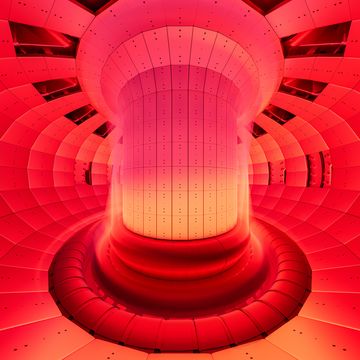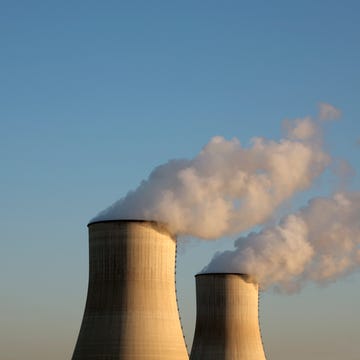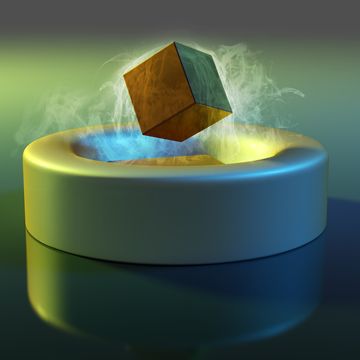Imagine a cheap, plentiful source of energy that could provide safe, emissions-free power for hundreds of years without refueling and without any risk of nuclear proliferation. The fuel is thorium, and it has been trumpeted by proponents as a "superfuel" that eludes many of the pitfalls of today's nuclear energy. But now, as a number of countries including China, India, and the United States explore the potential use of thorium for nuclear power, researchers say one of the biggest claims made about the fuel—its proliferation resistance—doesn't add up.
"It may not be as resistant as touted and in some cases the risk of proliferation may be worse than other fuels," says Stephen Ashley of the University of Cambridge. In an article published in the journal Nature online today, Ashley and his colleagues highlight the potential dangers of thorium fuel.
When thorium is irradiated, or exposed to radiation to prepare it for use as a fuel in nuclear reactions, the process forms small amounts of uranium-232. That highly radioactive isotope makes any handling of the fuel outside of a large reactor or reprocessing facility incredibly dangerous. The lethal gamma rays uranium-232 emits make any would-be bomb-maker think twice before trying to steal thorium.
But Ashley and his co-authors say a simple tweak in the thorium irradiation recipe can sidestep the radioactive isotope's formation. If an element known as protactinium-233 is extracted from thorium early in the irradiation process, no uranium-232 will form. Instead, the separated protactinium-233 will decay into high purity uranium-233, which can be used in nuclear weapons.
"Eight kilograms of uranium-233 can be used for a nuclear weapon," Ashley says. "The International Atomic Energy Agency views it the same as plutonium in terms of proliferation risk."
Creating weapons-grade uranium in this way would require someone to have access to a nuclear reactor during the irradiation of thorium fuel, so it's not likely a terrorist group would be able to carry out the conversion. The bigger threat is that a country pursuing nuclear energy and nuclear weapons (say, Iran) could make both from thorium. "This technology could have a dual civilian and military use," Ashley says.
Laurence O'Hagan is the CEO of the Weinberg Foundation, a non-profit organization promoting the development of thorium fuel. Responding to Ashley's Nature article, O'Hagan says proliferation concerns are overstated. "There are proliferation issues with anything nuclear," he says. "But if you are out to make a bomb, you go after plutonium rather than thorium and uranium-233. It's too difficult to handle."
Thierry Dujardin, deputy director for science and development of the Organisation for Economic Co-operation and Development's Nuclear Energy Agency takes a middle of the road approach to concerns over proliferation with thorium. "It's probably as wrong to claim there is no proliferation concern as to say it's worse than other fuels," Dujardin says.
Interest in thorium has been growing in recent years. After the recent nuclear disaster in Fukushima, Japan, some see it as a safer alternative to nuclear reactors powered by uranium. O'Hagan advocates for the use of liquid thorium fuel in high-temperature molten salt reactors. The combination, he says, would allow for small modular reactors that are safer than existing technology and yield far less nuclear waste.
In a paper published after his death in 2003, Edward Teller, the "father of the hydrogen bomb," argued for a reactor that, when buried underground, could operate safely for 200 years without refueling. Such a reactor would eliminate the possibility of meltdown, O'Hagan says. "Fukushima would not have happened, Chernobyl would not have happened, Three Mile Island would not have happened."
However, Dujardin says, a number of advanced reactor designs, including molten salt reactors, provide similar benefits and can use existing uranium-based fuel. And for cost reasons alone, Dujardin says it may be better to continue developing next-generation reactor designs using existing uranium fuel technology.
"When a technology is in some difficulty, and nuclear technology has been shocked by the Fukushima accident in Japan, people search for a magic solution, but there is no silver bullet," he says. "The difference in the state of development of thorium versus other sources of fuel is so vast and the cost of developing the technology is so high, it's really questionable today whether it's worthwhile to spend a lot of money on the development of thorium."
One possible exception that may make thorium more promising is its abundance. The world's thorium supply is estimated to be several times greater than that of uranium. If the world continues to use existing "open" reactor designs, which only use a small portion of the uranium fuel that passes through a reactor before being discarded as waste, then fuel scarcity could become an issue.
"If you go to fast neutron reactors with a closed fuel cycle there is enough uranium for thousands of years," Dujardin says. "But if for any reason there are large difficulties with this option, thorium would be worth investigating."













